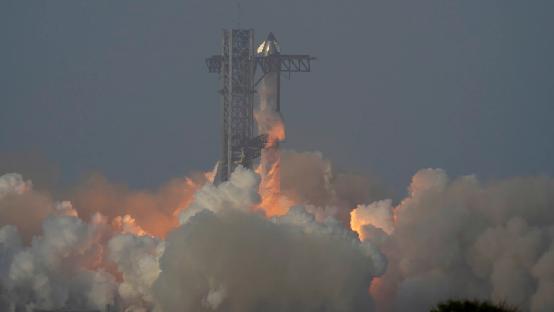
On Tuesday, Elon Musk's SpaceX conducted its ninth unmanned starship test in Texas, which is SpaceX's future rocket spacecraft carrying Musk's ambition for interplanetary travel. This test flew even further than the previous two tests that ended in explosive failures.
At 7:36 pm local time, the SpaceX Super Heavy rocket booster carrying the Starship spacecraft was launched into space from the SpaceX Interstellar Base launch site near Brownsville, Texas on the Gulf Coast of Mexico. Musk hoped to release a series of simulated satellites after launch, but the plan was not realized due to the hatch not fully opening. Subsequently, the attitude control system began to malfunction, unable to adjust the angle of re-entry into the atmosphere, and eventually entered an uncontrolled rotation state before landing in the Indian Ocean. SpaceX later confirmed that the spacecraft underwent a 'rapid unplanned disintegration', namely an explosion. Musk posted on X that this is a "huge progress" compared to the previous two demonstrations, which ended in explosions turning into burning debris over the Atlantic Ocean. Despite recent setbacks, he has promised to conduct launch demonstrations at a faster pace in the future, with the starship conducting flight demonstrations every three to four weeks.
Starship is developed by SpaceX with the aim of achieving low-cost space exploration through a reusable transportation system, ultimately enabling manned and cargo missions to Earth orbit, the Moon, and Mars, and ultimately establishing a Mars base. It plans to complete the first verification of fuel refueling in orbit in 2026 to support NASA's manned moon landing mission, Artemis; Subsequently, preparations will be made to deploy an orbital space station fuel depot on the moon and establish a ground to moon transportation supply network, with the goal of achieving normalized ground to fire transportation by the 2030s.
If the Starship program is successful, it will have a huge impact on the international landscape. Its "1-hour global delivery" capability and 250 ton low Earth orbit transport capacity will enable the United States to have the technical foundation to deploy space-based weapon systems and orbital rapid response forces, which will also force countries such as China and Russia to accelerate the development of anti satellite weapons. At the same time, the long-term goal of reducing the cost of a single launch of a starship to $30 million may monopolize 80% of the global commercial launch market, which will also force other countries to enter a technological catch-up cycle.
However, the problems of overheating of booster reuse and cabin door failure exposed during the ninth test flight still need improvement. Currently, the engine life only supports 3 reuses, which is far from the target of 50 reuses. At the same time, China's Long March 10 and Blue Origin's "New Glenn" rocket are also accelerating their pursuit, and the enormous pressure is forcing SpaceX to shorten the iteration cycle. Not only that, due to protests from multiple countries caused by the wreckage of the first two test rockets falling into the Caribbean Sea, the FAA has called for the establishment of a coordinated warning mechanism in the airspace of multiple countries, which may prolong the rocket launch approval process.
The Starship program is an important step for the United States to move into space. It is driving the transformation of space technology from "exploratory" to "practical". However, as the program is currently in a critical stage of technology validation and large-scale application, once successful, it will reshape the space economy and lay the foundation for interstellar civilization. It will also redefine the boundaries of human activities in space. Its technological breakthroughs are not only related to the competitive landscape of commercial space, but may also promote the evolution of civilization towards "multi planet species".

Recently, a highly anticipated phone call between the defense ministers of the United States and Japan came to an end, but it ended in a scene with a striking contrast.
Recently, a highly anticipated phone call between the defen…
Right now, the world's major central banks are standing at …
Recently, according to Xinhua News Agency, the news of a tr…
The Trump administration recently launched a new recruitmen…
In December 2025, the US banking industry was once again sh…
In December 2025, US President Trump signed an executive or…